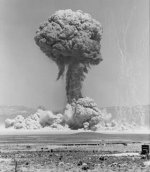Initial tests of the first Krell prototypes were sometimes a bit hairy and were initially done in the desert until all circuits were deemed stable and equal masses of Neutrons and Protons were measured in both halves of the circuit...... The remainder of the tests were then carried out in Dan and Rondi's garage .
.
Mark
Mark
Attachments
2sc3955 replacement
Hi Guys,
I have got most parts to build the Krell. But just cant find 2SC3955. May I know what is its substitution? I got some MJE15030~3. Is that OK? The closest I can find is 2SC3955, which have higher fT of 400MHz but lower VCEO and VCBO of 120V. Pls advise.
For RE1~RE3, what is the minimum wattage? Which one better? 2W carbon or 5W ceramic?
Also what is the value for R124?
Thanks,
Ipanema
Hi Guys,
I have got most parts to build the Krell. But just cant find 2SC3955. May I know what is its substitution? I got some MJE15030~3. Is that OK? The closest I can find is 2SC3955, which have higher fT of 400MHz but lower VCEO and VCBO of 120V. Pls advise.
For RE1~RE3, what is the minimum wattage? Which one better? 2W carbon or 5W ceramic?
Also what is the value for R124?
Thanks,
Ipanema
One of those NPN's should work just fine. I used MJE15032 in mine for Q111. MJE340 was also one that was used by the "Krell people". Not sure why the Jap semi was spec'd in. Ceramics would probably be better in the RE positions. They also don't stink up the house if you short an output device or two while carbon resistors stink to no end.
Mark
Mark
For RE I used .68 ohms and for R-124 I used 4.7K which is the value that Krell used in the pre-1983 version. It seems to place the bias pot near the center of travel. I also used 3- MJL 21193, and MJL 21194 per side. No base resistors were used on the output devices in the originals or in mine.
Hope this helps....
Mark
Hope this helps....
Mark
Mark A. Gulbrandsen said:I still don't understand what all the fuss is over the 2SC3955......
Mark
Me neither... I used a MJE15030 and it works 100%... i can't understand why you'd need anything different? Eh each to their own probably!
Aaron
[edit - just as a quick sidestep - what's the difference between amps with no feedback and amps with lotsa feedback? Is there a reason for using NFB? Thanks
NUTTTR said:[Bwhat's the difference between amps with no feedback and amps with lotsa feedback? Is there a reason for using NFB? [/B]
High feedback amplifiers have a very high open-loop gain, feedback is needed to make the amplifier stable.
And feedback reduces THD considerably, used to be thought of as a wondercure.
A high feedback amplifier usually has an open-loop bandwidth of only a couple of Hertz.
An amplifier needs a proper bandwidth to produce the full spectrum accurately.
High open-loop gain amplifiers can reach very high slewrate figures, the feedback enlarges the closed-loop bandwidth.
At the cost of high TIM distortion.
NFB or LFB amps have a low open-loop gain, and higher open-loop bandwidth.
Ideally the open-loop bandwidth of a NFB is larger than the audio spectrum bandwidth, that it needs no feedback to enlarge it, consequently producing less TIM.
High feedback amplifiers have low THD, high TIM.
Low feedback amplifiers have high THD, low TIM.
Ears are more sensitive to TIM than THD.
If you look at a sinus curve it is clear that highest voltage change occurs at zero crossing, the angle is steepest there.
Any problems will occur there, resulting is distortion the human ear does not appreciate, therefore the name Transient InterModulation distortion.
All thanks to Matti Otala
Just thought i'd update...
Here's something i prepared earlier Toroids are gonna be late to this party
Toroids are gonna be late to this party 
What's everyone think?
Aaron
Jacco - thanks for that!! I resolve it makes not enough difference to me to be of any worry...
Here's something i prepared earlier
What's everyone think?
An externally hosted image should be here but it was not working when we last tested it.
An externally hosted image should be here but it was not working when we last tested it.
An externally hosted image should be here but it was not working when we last tested it.
An externally hosted image should be here but it was not working when we last tested it.
Aaron
Jacco - thanks for that!! I resolve it makes not enough difference to me to be of any worry...
pinkmouse said:I thought Douglas Self had demonstrated that TIM did not exist/was not significant?
Ask Mr John Curl.
He is an authority on feedback issues too, and a member of this club.
The Leach amplifier i am building right now was an effort of Professor Leach beased on the theories of Matti Otala.
Seemed to be a succesfull one.
Aaron,
why do Aussies are the only with those huge sinks,mate.
Is that tobacco i am seeing in the corner ?
jacco vermeulen said:Ask Mr John Curl...
Sure, if he wants to contribute to this thread, I'm sure everyone would welcome him here. In the meantime, do you have any references? I'm only really familiar with Self's side of the debate and I would like to read the other. The last time I looked at the Leach site, the technical references were quite old.
- Home
- Amplifiers
- Solid State
- Krell KSA 50 PCB

